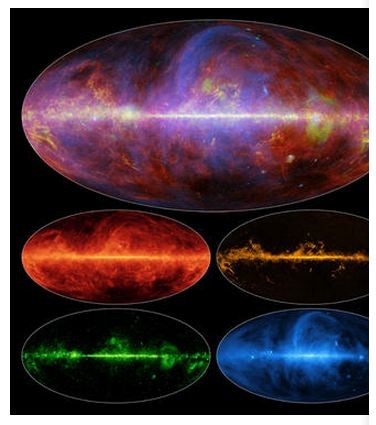Stunning New Map of the Milky Way is the Best Yet
| Arthur Dominic Villasanta | | Feb 08, 2015 07:30 PM EST |
(Photo : NASA/JPL/ESA) New map of the Milky Way consists of several views
A marvelous new interactive map of Milky Way lets you see a lot more detail in our galaxy while also shedding more light on dark matter and the origins of the Universe.
NASA's Jet Propulsion Laboratory (JPL) in California said the image was produced by the European Space Agency's Planck spacecraft from 2009 to late 2013 as it orbited the Earth. Planck used its telescope to capture relic radiation from the Cosmic Microwave Background or CMB, the thermal radiation left over from the "Big Bang" that occurred 13.8 billion years ago.
Like Us on Facebook
Planck's mission was to look back in time to 370,000 years after the Big Bang.
JPL, which worked closely with ESA on the Planck mission, has just made public a captivating interactive map of the Milky Way using Planck's data. You can view it on the Planck website at http://planck.ipac.caltech.edu/wwt/.
The map consists of of several different views of the Milky Way: Dust Glow; Carbon Monoxide Gas and Magnetic Fields.
The image combines multiple views of the Milky Way, and shows dust, carbon monoxide gas, magnetic fields and a type of radiation known as "free-free." This kind of radiation occurs when isolated electrons and protons careen past one another in a series of near collisions, slowing down but continuing on their own way.
Analyzing data sent back by the Planck mission also discovered that the "Dark Ages" of our universe, or the time before stars formed, lasted for about 550 million years after the Big Bang instead of the 300 million to 400 million years as is the accepted theory.
The Planck data also supports the idea that the mysterious force known as dark energy is acting against gravity to push our universe apart at ever-increasing speeds, JPL said.
©2015 Chinatopix All rights reserved. Do not reproduce without permission
EDITOR'S PICKS
-

Did the Trump administration just announce plans for a trade war with ‘hostile’ China and Russia?
-

US Senate passes Taiwan travel bill slammed by China
-

As Yan Sihong’s family grieves, here are other Chinese students who went missing abroad. Some have never been found
-

Beijing blasts Western critics who ‘smear China’ with the term sharp power
-

China Envoy Seeks to Defuse Tensions With U.S. as a Trade War Brews
-

Singapore's Deputy PM Provides Bitcoin Vote of Confidence Amid China's Blanket Bans
-

China warns investors over risks in overseas virtual currency trading
-

Chinese government most trustworthy: survey
-

Kashima Antlers On Course For Back-To-Back Titles
MOST POPULAR
LATEST NEWS
Zhou Yongkang: China's Former Security Chief Sentenced to Life in Prison

China's former Chief of the Ministry of Public Security, Zhou Yongkang, has been given a life sentence after he was found guilty of abusing his office, bribery and deliberately ... Full Article
TRENDING STORY

China Pork Prices Expected to Stabilize As The Supplies Recover

Elephone P9000 Smartphone is now on Sale on Amazon India

There's a Big Chance Cliffhangers Won't Still Be Resolved When Grey's Anatomy Season 13 Returns

Supreme Court Ruled on Samsung vs Apple Dispute for Patent Infringement

Microsoft Surface Pro 5 Rumors and Release Date: What is the Latest?










